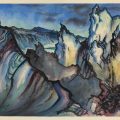Chiura Obata’s Glorious Struggle
Sidedoor explores the power of art in tumultuous times.

When Chiura Obata painted “Moonlight Over Topaz, Utah,” he was a prisoner at the camp: one of 120,000 Japanese Americans to be incarcerated during World War II. The painting shows a dreamy moonlit desert, with just a few dark lines to hint at the barbed wire fences and guard towers that held him and his family captive. As a painter, Obata turned again and again to nature as his greatest teacher, and his greatest subject. Today, his work can be found in art collections and museums around the world, including the Smithsonian American Art Museum. This time on Sidedoor, we learn from Chiura Obata about the power of art in tumultuous times.
Listen Now
Speakers
Rihoko Ueno: Processing archivist at the Smithsonian’s Archives of American Art
Noriko Sanefuji: Museum specialist in the Division of Cultural and Community Life at the Smithsonian’s National Museum of American History @apacurator @amhistorymuseum
ShiPu Wang: Coats Endowed Chair in the Arts and Professor of Art History at The University of California Merced. Curator of the traveling exhibition, “Chiura Obata: An American Modern.” @curatingobata
Kimi Hill: Chiura Obata’s granddaughter and author of the book, “Topaz Moon.”
Watch
Want to learn more?
Smithsonian’s American Art Museum: Chiura Obata
Smithsonian Transcription Center: Correspondence with Eleanor Roosevelt
Posted: 16 December 2021








